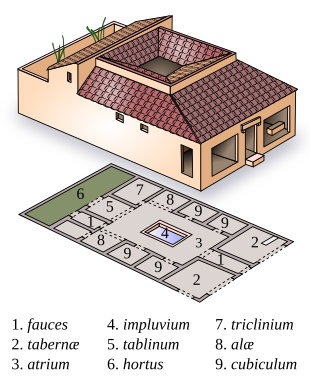
In Roman architecture, a tablinum (or tabulinum, from tabula, board, picture) was a room generally situated on one side of the atrium and opposite to the entrance; it opened in the rear onto the peristyle, with either a large window or only an anteroom or curtain. The walls were richly decorated with fresco pictures, and busts of the family were arranged on pedestals on the two sides of the room.[1]
YouTube Encyclopedic
-
1/1Views:833
-
Rome MVR App - Stand Intel GSMA Barcellona
Transcription
Description

The tablinum was the office in a Roman house, the father's centre for business, where he would receive his clients. It was originally the master bedroom, but later became the main office and reception room for the house master.
Takhtabush
Takhtabush is the Arabic term for a tablinum. Like the ancient Roman tablinum, it opens onto a heavily shaded courtyard and, on the other side, a rear garden. Unlike the Roman tablinum, the garden side is closed with a mashrabiya lattice[2]: Ch. 6 (Roman tablinums may have had open-weave curtains[citation needed]).
If there is a wind, it tends to blow down into the windward court and up out of the leeward court.[2]: Ch. 6 A draft can, however, be driven by convection. One of the courts will generally be hotter than the other; which is hotter may vary.[2]: Ch. 6 [3] The courtyard is often pale, paved and narrow, and may be shaded by an awning and evaporatively cooled by a fountain. The garden is generally darker in colour, but evaporatively-cooled by evapotranspiration[citation needed]. The larger court will generally be less shaded by its own walls, and more exposed to hot winds; it may also be less sheltered by surrounding rooms.[2]: Ch. 6 [4] From both wind pressure and convection forces, the hottest air in the hotter court rises and escapes over the wall, pulling fresh air from the cooler courtyard through the takhtabush into the hotter court.[2]: Ch. 6 [4] The cooler court is replenished with air from the side (drawn through doors, evaporatively-cooled projecting mashrabiya bow windows, and small vents in the wall), or from above[citation needed], which cools by contact with masonry and evaporative cooling. The takhtabush thus has a strong cross-breeze from the cooler court. The breeze is at least partly driven by convection, and may also be driven by wind pressure and evaporative cooling,[2]: Ch. 6 [4][3] so the gardens and courtyards are used as windcatchers.
Similar systems may be used to create a cool, breezy public roofed space between two public squares.[2]: Ch. 6
See also
- Tsubo-niwa – a similar traditional Japanese architectural element
References
- ^ One or more of the preceding sentences incorporates text from a publication now in the public domain: Chisholm, Hugh, ed. (1911). "Tablinum". Encyclopædia Britannica. Vol. 26 (11th ed.). Cambridge University Press. p. 337.
- ^ a b c d e f g Fathy, Hassan. "The wind factor in air movement". Natural Energy and Vernacular Architecture.
- ^ a b Ford, Brian (September 2001). "Passive downdraught evaporative cooling: principles and practice" (PDF). Architectural Research Quarterly. 5 (3): 271–280. doi:10.1017/S1359135501001312. S2CID 110209529.
- ^ a b c Mohamed, Mady A. A. (2010). S. Lehmann; H.A. Waer; J. Al-Qawasmi (eds.). Traditional Ways of Dealing with Climate in Egypt. The Seventh International Conference of Sustainable Architecture and Urban Development (SAUD 2010). Sustainable Architecture and Urban Development. Amman, Jordan: The Center for the Study of Architecture in Arab Region (CSAAR Press). pp. 247–266. (low-res bw version)
Further reading
- Mohamed, Mady Ahmed (30 January 2018). "The mastery of the Takhtabush as a paradigm traditional design element in the hot zone climate". EQA - International Journal of Environmental Quality. 28: 1–11. doi:10.6092/issn.2281-4485/7661. ISSN 2281-4485.
- Ford, Brian (September 2001). "Passive downdraught evaporative cooling: principles and practice" (PDF). Architectural Research Quarterly. 5 (3): 271–280. doi:10.1017/S1359135501001312. S2CID 110209529.
